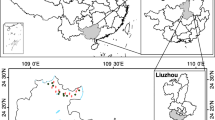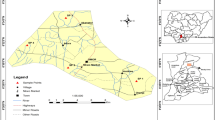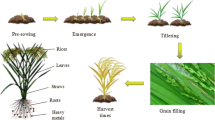Abstract
Consumption of food crops contaminated with heavy metals is the most pressing concerns for food security and human health. A comprehensive analysis of heavy metal bioconcentrations in different plant organs can provide a basis for adjusting crop planting structure to reduce the migration of heavy metals from soil to crop. In this study, the concentrations of Cr, Ni, Cu, Zn, As, Cd, Hg, and Pb in the soil and rice from paddy fields in the Naoli River Basin were determined, and the health risks associated with the rice ingestion were also assessed. We found that the soil contaminated with heavy metals was at moderate pollution level and ecological risk. Most heavy metals, including Cr, Ni, Cu, As, Cd, and Pb, mainly accumulated in the root of rice. All the rice organs exhibited weak abilities to accumulate Pb, whereas the root, stem, and leaf had the strongest abilities to accumulate As, and grain had the strongest ability to accumulate Zn. The concentrations of Ni and As in the rice grain samples partially exceeded the permitted concentrations. The non-carcinogenic risk of As was considered significant, and its target hazard quotient values for both children and adults were > 1. The target carcinogenic risk values of Ni, As, and Cr for both children and adults were > 1×10−4, indicating their potential carcinogenic risks. The findings provide important information for decision-makers to ensure food crop safety production and environmental management.
Graphical abstract






Similar content being viewed by others
References
Arao T, Ishikawa S, Murakami M, Abe K, Maejima Y, Makino T (2010) Heavy metal contamination of agricultural soil and countermeasures in Japan. Paddy Water Environ 8(3):247–257. https://doi.org/10.1007/s10333-010-0205-7
Arita A, Niu JP, Qu QS, Zhao NJ, Ruan Y, Nadas A, Chervona Y, Wu F, Sun H, Hayes RB, Costa M (2012) Global levels of histone modifications in peripheral blood mononuclear cells of subjects with exposure to nickel. Environ Health Perspect 120(2):198–203. https://doi.org/10.1289/ehp.1104140
Bolan S, Kunhikrishnan A, Chowdhury S, Seshadri B, Naidu R, Ok YS (2017) Comparative analysis of speciation and bioaccessibility of arsenic in rice grains and complementary medicines. Chemosphere 182:433–440. https://doi.org/10.1016/j.chemosphere.2017.04.126
Caballero-Gallardo K, Alcala-Orozco M, Barraza-Quiroz D, De la Rosa J, Olivero-Verbel J (2020) Environmental risks associated with trace elements in sediments from Cartagena Bay, an industrialized site at the Caribbean. Chemosphere 242:125173. https://doi.org/10.1016/j.chemosphere.2019.125173
CEMC (China Environmental Monitoring Centre) (1990) Chinese soil element background values. China Environmental Science Press, Beijing
Chen HY, Teng YG, Lu SJ, Wang YY, Wang JS (2015) Contamination features and health risk of soil heavy metals in China. Sci Total Environ 512:143–153. https://doi.org/10.1016/j.scitotenv.2015.01.025
Chen P, Geng N, Zhou D, Zhu YR, Xu YL, Liu KP, Liu YX, Liu JZ (2019) The regulatory role of COX-2 in the interaction between Cr(VI)-induced endoplasmic reticulum stress and autophagy in DF-1 cells. Ecotox Environ Safe 170:112–119. https://doi.org/10.1016/j.ecoenv.2018.11.120
Chen T, Liu XM, Zhu MZ, Zhao KL, Wu JJ, Xu JM, Huang PM (2008) Identification of trace element sources and associated risk assessment in vegetable soils of the urban-rural transitional area of Hangzhou, China. Environ Pollut 151(1):67–78. https://doi.org/10.1016/j.envpol.2007.03.004
Clemens S, Ma JF (2016) Toxic heavy metal and metalloid accumulation in crop plants and foods. Annu Rev Plant Biol 67:489–512. https://doi.org/10.1146/annurev-arplant-043015-112301
Conte F, Copat C, Longo S, Conti GO, Grasso A, Arena G, Brundo MV, Ferrante M (2015) First data on trace elements in Haliotis tuberculata (Linnaeus, 1758) from southern Italy: Safety issues. Food Chem Toxicol 81:143–150. https://doi.org/10.1016/j.fct.2015.04.020
Cristaldi A, Conti GO, Cosentino SL, Mauromicale G, Copat C, Grasso A, Zuccarello P, Fiore M, Restuccia C, Ferrante M (2020) Phytoremediation potential of Arundo donax (Giant Reed) in contaminated soil by heavy metals. Environ Res 185:109427. https://doi.org/10.1016/j.envres.2020.109427
Ding XG, Ye SY, Laws EA, Mozdzer TJ, Yuan HM, Zhao GM, Yang SX, He L, Wang J (2019) The concentration distribution and pollution assessment of heavy metals in surface sediments of the Bohai Bay, China. Mar Pollut Bull 149:110497. https://doi.org/10.1016/j.marpolbul.2019.110497
Duan GL, Liu WJ, Chen XP, Hu Y, Zhu YG (2013) Association of arsenic with nutrient elements in rice plants. Metallomics 5(7):784–792. https://doi.org/10.1039/c3mt20277a
Ferrante M, Napoli S, Grasso A, Zuccarello P, Cristaldi A, Copat C (2019) Systematic review of arsenic in fresh seafood from the Mediterranean Sea and European Atlantic coasts: a health risk assessment. Food Chem Toxicol 126:322–331. https://doi.org/10.1016/j.fct.2019.01.010
Filippini T, Malagoli C, Wise LA, Malavolti M, Pellacani G, Vinceti M (2019) Dietary cadmium intake and risk of cutaneous melanoma: an Italian population-based case-control study. J Trace Elem Med Biol 56:100–106. https://doi.org/10.1016/j.jtemb.2019.08.002
Filippini T, Torres D, Lopes C, Carvalho C, Moreira P, Naska A, Kasdagli MI, Malavolti M, Orsini N, Vinceti M (2020) Cadmium exposure and risk of breast cancer: a dose-response meta-analysis of cohort studies. Environ Int 142:105879. https://doi.org/10.1016/j.envint.2020.105879
Fiore M, Conti GO, Caltabiano R, Buffone A, Zuccarello P, Cormaci L, Cannizzaro MA, Ferrante M (2019) Role of emerging environmental risk factors in thyroid cancer: a brief review. Int J Env Res Pub He 16(7):1185. https://doi.org/10.3390/ijerph16071185
Fu YG, Hu X, Yu SX (1999) Study on the tolerance limit of nickel in foods. Acta Academiae Medicinae Zhejiang 37:9–11
Ghosh M, Singh SP (2005) A comparative study of cadmium phytoextraction by accumulator and weed species. Environ Pollut 133(2):365–371. https://doi.org/10.1016/j.envpol.2004.05.015
Hakanson L (1980) An ecological risk index for aquatic pollution control, a sedimentological approach. Water Res 14(8):975–1001. https://doi.org/10.1016/0043-1354(80)90143-8
Huang ML, Zhou SL, Sun B, Zhao QG (2008) Heavy metals in wheat grain: assessment of potential health risk for inhabitants in Kunshan, China. Sci Total Environ 405(1–3):54–61. https://doi.org/10.1016/j.scitotenv.2008.07.004
Ihedioha JN, Ukoha PO, Ekere NR (2017) Ecological and human health risk assessment of heavy metal contamination in soil of a municipal solid waste dump in Uyo, Nigeria. Environ Geochem Hlth 39(3):497–515. https://doi.org/10.1007/s10653-016-9830-4
Islam MA, Akber MA, Rahman MB, Rahman MA, Haque MA, Islam MA (2019) Trace elements in rice grain and agricultural soils: assessment of health risk of inhabitants near a former secondary lead smelter in Khulna, Bangladesh. Environ Geochem Hlth 41(6):2521–2532. https://doi.org/10.1007/s10653-019-00299-2
Islam MS, Ahmed MK, Al-Mamun MH, Eaton DW (2020) Human and ecological risks of metals in soils under different land-use types in an urban environment of Bangladesh. Pedosphere 30(2):201–213. https://doi.org/10.1016/S1002-0160(17)60395-3
Jayasumana C, Fonseka S, Fernando A, Jayalath K, Amarasinghe M, Siribaddana S, Gunatilake S, Paranagama P (2015) Phosphate fertilizer is a main source of arsenic in areas affected with chronic kidney disease of unknown etiology in Sri Lanka. SpringerPlus 4:90. https://doi.org/10.1186/s40064-015-0868-z
Khan S, Cao Q, Zheng YM, Huang YZ, Zhu YG (2008) Health risks of heavy metals in contaminated soils and food crops irrigated with wastewater in Beijing, China. Environ Pollut 152(3):686–692. https://doi.org/10.1016/j.envpol.2007.06.056
Lamm SH, Robbins S, Chen RS, Lu J, Goodrich B, Feinleib M (2014) Discontinuity in the cancer slope factor as it passes from high to low exposure levels-arsenic in the BFD-endemic area. Toxicology 326:25–35. https://doi.org/10.1016/j.tox.2014.08.014
Li TY, Chang Q, Yuan XY, Li JZ, Ayoko GA, Frost RL, Chen HY, Zhang XJ, Song YX, Song WZ (2017) Cadmium transfer from contaminated soils to the human body through rice consumption in southern Jiangsu Province, China. Environ Sci-Proc Imp 19(6):843–850. https://doi.org/10.1039/c6em00631k
Li TY, Song YX, Yuan XY, Li JZ, Ji JF, Fu XW, Zhang Q, Guo SH (2018) Incorporating bioaccessibility into human health risk assessment of heavy metals in rice (Oryza sativa L.): a probabilistic-based analysis. J Agric Food Chem 66(22):5683–5690. https://doi.org/10.1021/acs.jafc.8b01525
Liu YM, Liu DY, Zhang W, Chen XX, Zhao QY, Chen XP, Zou CQ (2020) Health risk assessment of heavy metals (Zn, Cu, Cd, Pb, As and Cr) in wheat grain receiving repeated Zn fertilizers. Environ Pollut 257:113581. https://doi.org/10.1016/j.envpol.2019.113581
MHPRC (Ministry of Health of the People’s Republic of China) (1991) Tolerance limit of zinc in foods (GB 13106-1991). MHPRC, Beijing
MHPRC (Ministry of Health of the People’s Republic of China) (1994) Tolerance limit of copper in foods (GB 15199-1994). MHPRC, Beijing
MHPRC (Ministry of Health of the People’s Republic of China) (2005) Maximum levels of contaminants in foods (GB 2762-2005). MHPRC, Beijing
MLRPRC (Ministry of Land and Resources of the PRC) (2016) Specification of land quality geochemical assessment (DZ/T 0295-2016). MLRPRC, Beijing
Omar NA, Praveena SM, Aris AZ, Hashim Z (2015) Health risk assessment using in vitro digestion model in assessing bioavailability of heavy metal in rice: a preliminary study. Food Chem 188:46–50. https://doi.org/10.1016/j.foodchem.2015.04.087
Praveena SM, Omar NA (2017) Heavy metal exposure from cooked rice grain ingestion and its potential health risks to humans from total and bioavailable forms analysis. Food Chem 235:203–211. https://doi.org/10.1016/j.foodchem.2017.05.049
Roy M, McDonald LM (2015) Metal uptake in plants and health risk assessments in metal-contaminated smelter soils. Land Degrad Dev 26(8):785–792. https://doi.org/10.1002/ldr.2237
Saint-Jacques N, Brown P, Nauta L, Boxall J, Parker L, Dummer TJB (2018) Estimating the risk of bladder and kidney cancer from exposure to low-levels of arsenic in drinking water, Nova Scotia, Canada. Environ Int 110:95–104. https://doi.org/10.1016/j.envint.2017.10.014
Shahrbabki PE, Hajimohammadi B, Shoeibi S, Elmi M, Yousefzadeh A, Conti GO, Ferrante M, Amirahmadi M, Fakhri Y, Khaneghah AM (2018) Probabilistic non-carcinogenic and carcinogenic risk assessments (Monte Carlo simulation method) of the measured acrylamide content in Tah-dig using QuEChERS extraction and UHPLC-MS/MS. Food Chem Toxicol 118:361–370. https://doi.org/10.1016/j.fct.2018.05.038
Song TJ, Cui G, Su XS, He J, Tong SZ, Liu Y (2020) The origin of soil selenium in a typical agricultural area in Hamatong River Basin, Sanjiang Plain, China. Catena 185:104355. https://doi.org/10.1016/j.catena.2019.104355
Song TJ, Su XS, He J, Liang YK, Zhou T (2018a) Source apportionment and health risk assessment of heavy metals in agricultural soils in Xinglonggang, Northeastern China. Hum Ecol Risk Assess 24(2):509–521. https://doi.org/10.1080/10807039.2017.1392232
Song TJ, Su XS, He J, Liang YK, Zhou T, Liu C (2018b) Selenium (Se) uptake and dynamic changes of Se content in soil-plant systems. Environ Sci Pollut R 25(34):34343–34350. https://doi.org/10.1007/s11356-018-3373-4
USEPA (United States Environmental Protection Agency) (2011) Exposure Factors Handbook 2011 Edition (Final Report). USEPA, Washington
Vatanpour N, Feizy J, Talouki HH, Es'haghi Z, Scesi L, Malvandi AM (2020) The high levels of heavy metal accumulation in cultivated rice from the Tajan river basin: Health and ecological risk assessment. Chemosphere 245:125639. https://doi.org/10.1016/j.chemosphere.2019.125639
Wang XT, Dan Z, Cui XQ, Zhang RX, Zhou SQ, Wenga T, Yan BB, Chen GY, Zhang QY, Zhong L (2020) Contamination, ecological and health risks of trace elements in soil of landfill and geothermal sites in Tibet. Sci Total Environ 715:136639. https://doi.org/10.1016/j.scitotenv.2020.136639
Wei RP, Wang X, Tang WL, Yang YC, Gao Y, Zhong H, Yang LY (2020) Bioaccumulations and potential human health risks assessment of heavy metals in ppk-expressing transgenic rice. Sci Total Environ 710:136496. https://doi.org/10.1016/j.scitotenv.2020.136496
Zang F, Wang SL, Nan ZR, Ma JM, Zhang Q, Chen YZ, Li YP (2017) Accumulation, spatio-temporal distribution, and risk assessment of heavy metals in the soil-corn system around a polymetallic mining area from the Loess Plateau, northwest China. Geoderma 305:188–196. https://doi.org/10.1016/j.geoderma.2017.06.008
Zhang M, Tang S, Huang X, Zhang F, Pang Y, Huang Q, Yi Q (2014) Selenium uptake, dynamic changes in selenium content and its influence on photosynthesis and chlorophyll fluorescence in rice (Oryza sativa L.). Environ Exp Bot 107:39–45. https://doi.org/10.1016/j.envexpbot.2014.05.005
Zheng SN, Wang Q, Yuan YZ, Sun WM (2020) Human health risk assessment of heavy metals in soil and food crops in the Pearl River Delta urban agglomeration of China. Food Chem 316:126213. https://doi.org/10.1016/j.foodchem.2020.126213
Zhong WG, Yang J, Chen ZD, Wang CL, Zhang YC, Chang ZZ, Zhou YJ (2006) Differences in accumulation and distribution of Pb, Cd, Hg and As in rice cultivars and their organs (Oryza sativa L.). Jiangsu Journal of Agricultural Sciences 22(4):331–338
Zhou H, Yang WT, Zhou X, Liu L, Gu JF, Wang WL, Zou JL, Tian T, Peng PQ, Liao BH (2016) Accumulation of heavy metals in vegetable species planted in contaminated soils and the health risk assessment. Int J Env Res Pub He:13. https://doi.org/10.3390/ijerph13030289
Zhou H, Zeng M, Zhou X, Liao BH, Peng PQ, Hu M, Zhu W, Wu YJ, Zou ZJ (2015) Heavy metal translocation and accumulation in iron plaques and plant tissues for 32 hybrid rice (Oryza sativa L.) cultivars. Plant Soil 386(1–2):317–329. https://doi.org/10.1007/s11104-014-2268-5
Availability of data and material
The datasets used and/or analyzed during the current study are available from the corresponding author on reasonable request.
Code availability
Not applicable.
Funding
This study was supported by National Natural Science Foundation of China (41871102), the National Key Research and Development Program of China (2016YFC0500403), and the Scientific and Technological Development Program of Jilin Province of China (20200201016JC).
Author information
Authors and Affiliations
Contributions
Writing (reviewing and editing), Tiejun Song; data analysis, Shouzheng Tong; investor of the project, Yu An. All authors read and approved the final manuscript.
Corresponding author
Ethics declarations
Ethics approval
Not applicable.
Consent to participate
Not applicable.
Consent for publication
Not applicable.
Conflict of interest
The authors declare no competing interests.
Additional information
Responsible Editor: Amjad Kallel
Highlights
• The heavy metals in the soil were at moderate pollution level and ecological risk.
• Most heavy metals in the rice organs mainly accumulated in the root.
• All the rice organs exhibited weak abilities to accumulate Pb.
• Ingestion of rice produced in the study area could cause health risks.
Rights and permissions
About this article
Cite this article
Song, T., Tong, S. & An, Y. Bioconcentrations and health risk assessment of heavy metals in paddy fields—a case study in Naoli River Basin, Sanjiang Plain, China. Arab J Geosci 14, 1988 (2021). https://doi.org/10.1007/s12517-021-08358-8
Received:
Accepted:
Published:
DOI: https://doi.org/10.1007/s12517-021-08358-8




